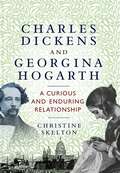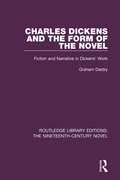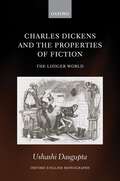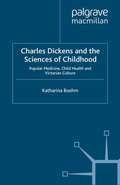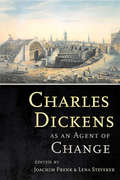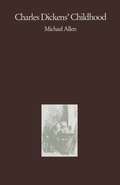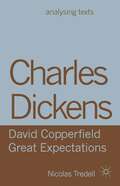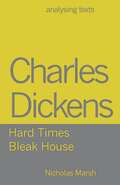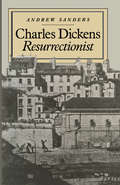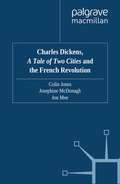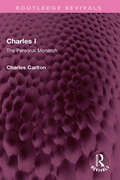- Table View
- List View
Charles Dickens and Georgina Hogarth: A curious and enduring relationship
by Christine SkeltonCharles Dickens called his sister-in-law Georgina Hogarth his ‘best and truest friend’. Georgina saw Dickens as much more than a friend. They lived together for twenty-eight years, during which time their relationship constantly changed. The sister of his wife Catherine, the sharp and witty Georgina moved into the Dickens home aged fifteen. What began as a father–daughter relationship blossomed into a genuine rapport, but their easy relations were fractured when Dickens had a mid-life crisis and determined to rid himself of Catherine. Georgina’s refusal to leave Dickens and his desire for her to remain in his household led to rumours of an affair and even illegitimate children. He left her the equivalent of almost £1 million and all his personal papers in his will. Georgina’s commitment to Dickens was unwavering but it is far from clear what he did to deserve such loyalty. There were several occasions when he misused her in order to protect his public reputation.Why did Georgina betray her once much-loved sister? Why did she fall out with her family and risk her reputation in order to stay with Dickens? And why did the Dickenses’ daughter Katey say it was ‘the greatest mistake ever’ to invite a sister-in-law to live with a family?
Charles Dickens and Georgina Hogarth: A curious and enduring relationship
by Christine SkeltonCharles Dickens called his sister-in-law Georgina Hogarth his ‘best and truest friend’. Georgina saw Dickens as much more than a friend. They lived together for twenty-eight years, during which time their relationship constantly changed. The sister of his wife Catherine, the sharp and witty Georgina moved into the Dickens home aged fifteen. What began as a father–daughter relationship blossomed into a genuine rapport, but their easy relations were fractured when Dickens had a mid-life crisis and determined to rid himself of Catherine. Georgina’s refusal to leave Dickens and his desire for her to remain in his household led to rumours of an affair and even illegitimate children. He left her the equivalent of almost £1 million and all his personal papers in his will. Georgina’s commitment to Dickens was unwavering but it is far from clear what he did to deserve such loyalty. There were several occasions when he misused her in order to protect his public reputation.Why did Georgina betray her once much-loved sister? Why did she fall out with her family and risk her reputation in order to stay with Dickens? And why did the Dickenses’ daughter Katey say it was ‘the greatest mistake ever’ to invite a sister-in-law to live with a family?
Charles Dickens and the Form of the Novel: Fiction and Narrative in Dickens' Work (Routledge Library Editions: The Nineteenth-Century Novel)
by Graham DaldryFirst published in 1987. While there have been commentaries on his humour, his seriousness, his social concerns, and other specific aspects of his work such accounts have only tended to divide our understanding of the novels, to lead us to see them as failures of artistic unity. In this book the author seeks to address this question of unity and find a terminology that can treat language, plot and representation of reality as a coherent imaginative effort. This thesis is worked out in detail with reference to several of the novels, and represents a challenging re-evaluation Dickens’ achievement as a novelist. This book will be if interest to student of literature.
Charles Dickens and the Form of the Novel: Fiction and Narrative in Dickens' Work (Routledge Library Editions: The Nineteenth-Century Novel)
by Graham DaldryFirst published in 1987. While there have been commentaries on his humour, his seriousness, his social concerns, and other specific aspects of his work such accounts have only tended to divide our understanding of the novels, to lead us to see them as failures of artistic unity. In this book the author seeks to address this question of unity and find a terminology that can treat language, plot and representation of reality as a coherent imaginative effort. This thesis is worked out in detail with reference to several of the novels, and represents a challenging re-evaluation Dickens’ achievement as a novelist. This book will be if interest to student of literature.
Charles Dickens and the Properties of Fiction: The Lodger World (Oxford English Monographs)
by Ushashi DasguptaWhen Dickens was nineteen years old, he wrote a poem for Maria Beadnell, the young woman he wished to marry. The poem imagined Maria as a welcoming landlady offering lodgings to let. Almost forty years later, Dickens died, leaving his final novel unfinished - in its last scene, another landlady sets breakfast down for her enigmatic lodger. These kinds of characters are everywhere in Dickens's writing. Charles Dickens and the Properties of Fiction: The Lodger World explores the significance of tenancy in his fiction. In nineteenth century Britain the vast majority of people rented, rather than owned, their homes. Instead of keeping to themselves, they shared space - renting, lodging, taking lodgers in, or simply living side-by-side in a crowded modern city. Charles Dickens explored both the chaos and the unexpected harmony to be found in rented spaces, the loneliness and sociability, the interactions between cohabitants, the complex gender dynamics at play, and the relationship between space and money. Charles Dickens and the Properties of Fiction demonstrates that a cosy, secluded home life was beyond the reach of most Victorian Londoners, and considers Dickens's nuanced conception of domesticity. Tenancy maintained an enduring hold upon his imagination, giving him new stories to tell and offering him a set of models to think about authorship. He celebrated the fact that unassuming houses brim with narrative potential: comedies, romances, and detective plots take place behind their doors. Charles Dickens and the Properties of Fiction: The Lodger World wedges these doors open.
Charles Dickens and the Properties of Fiction: The Lodger World (Oxford English Monographs)
by Ushashi DasguptaWhen Dickens was nineteen years old, he wrote a poem for Maria Beadnell, the young woman he wished to marry. The poem imagined Maria as a welcoming landlady offering lodgings to let. Almost forty years later, Dickens died, leaving his final novel unfinished - in its last scene, another landlady sets breakfast down for her enigmatic lodger. These kinds of characters are everywhere in Dickens's writing. Charles Dickens and the Properties of Fiction: The Lodger World explores the significance of tenancy in his fiction. In nineteenth century Britain the vast majority of people rented, rather than owned, their homes. Instead of keeping to themselves, they shared space - renting, lodging, taking lodgers in, or simply living side-by-side in a crowded modern city. Charles Dickens explored both the chaos and the unexpected harmony to be found in rented spaces, the loneliness and sociability, the interactions between cohabitants, the complex gender dynamics at play, and the relationship between space and money. Charles Dickens and the Properties of Fiction demonstrates that a cosy, secluded home life was beyond the reach of most Victorian Londoners, and considers Dickens's nuanced conception of domesticity. Tenancy maintained an enduring hold upon his imagination, giving him new stories to tell and offering him a set of models to think about authorship. He celebrated the fact that unassuming houses brim with narrative potential: comedies, romances, and detective plots take place behind their doors. Charles Dickens and the Properties of Fiction: The Lodger World wedges these doors open.
Charles Dickens and the Sciences of Childhood: Popular Medicine, Child Health and Victorian Culture (Palgrave Studies in Nineteenth-Century Writing and Culture)
by K. BoehmThis book takes a fresh look at childhood in Dickens' works and in Victorian science and culture more generally. It offers a new way of understanding Dickens' interest in childhood by showing how his fascination with new scientific ideas about childhood and practices of scientific inquiry shaped his narrative techniques and aesthetic imagination.
Charles Dickens as an Agent of Change
Sixteen scholars from across the globe come together in Charles Dickens as an Agent of Change to show how Dickens was (and still is) the consummate change agent. His works, bursting with restless energy in the Inimitable's protean style, registered and commented on the ongoing changes in the Victorian world while the Victorians' fictional and factional worlds kept (and keep) changing. The essays from notable Dickens scholars—Malcolm Andrews, Matthias Bauer, Joel J. Brattin, Doris Feldmann, Herbert Foltinek, Robert Heaman, Michael Hollington, Bert Hornback, Norbert Lennartz, Chris Louttit, Jerome Meckier, Nancy Aycock Metz, David Paroissien, Christopher Pittard, and Robert Tracy—suggest the many ways in which the notion of change has found entry into and is negotiated in Dickens' works through four aspects: social change, political and ideological change, literary change, and cultural change. An afterword by the late Edgar Rosenberg adds a personal account of how Dickens changed the life of one eminent Dickensian.
Charles Dickens: David Copperfield/ Great Expectations (Analysing Texts)
by Nicolas TredellDavid Copperfield and Great Expectations are among Charles Dickens's most famous novels. In both books, the hero tells the vivid and absorbing tale of his education by life, presents a rich range of characters and scenes, and tackles profound moral, social and psychological themes.Part I of this essential study:• provides lucid and penetrating analyses of key passages• discusses the crucial topics of patriarchy, class, obsession, eccentricity, death, breakdown and recovery• summarizes the methods of analysis and offers suggestions for further work.Part II supplies key background material, including:• an account of Dickens's life and works• a survey of historical, cultural and literary contexts• samples of significant criticism.Also featuring a valuable Further Reading section, this volume provides readers with the critical and analytical skills which will enable them to enjoy and explore both novels for themselves.
Charles Dickens: David Copperfield/ Great Expectations (Analysing Texts)
by Nicolas TredellDavid Copperfield and Great Expectations are among Charles Dickens's most famous novels. In both books, the hero tells the vivid and absorbing tale of his education by life, presents a rich range of characters and scenes, and tackles profound moral, social and psychological themes.Part I of this essential study:- Provides lucid and penetrating analyses of key passages- Discusses the crucial topics of patriarchy, class, obsession, eccentricity, death, breakdown and recovery- Summarizes the methods of analysis and offers suggestions for further workPart II supplies key background material, including:- An account of Dickens's life and works- A survey of historical, cultural and literary contexts- Samples of significant criticismAlso featuring a valuable Further Reading section, this volume provides readers with the critical and analytical skills which will enable them to enjoy and explore both novels for themselves.
Charles Dickens - Hard Times/Bleak House (Analysing Texts)
by Nicholas MarshThis stimulating study takes a fresh look at two of Dickens' most widely-studied texts. Part I uses carefully selected short extracts for close textual analysis, while Part II examines the historical and literary contexts and key criticism. The volume is an ideal introductory guide for those who are studying Dickens' novels for the first time.
Charles Dickens - Hard Times/Bleak House (Analysing Texts)
by Nicholas MarshThis stimulating study takes a fresh look at two of Dickens' most widely-studied texts. Part I uses carefully selected short extracts for close textual analysis, while Part II examines the historical and literary contexts and key criticism. The volume is an ideal introductory guide for those who are studying Dickens' novels for the first time.
The Charles Dickens Miscellany (Miscellany Ser.)
by Jeremy ClarkeCharles Dickens’ life was staggeringly busy and various. This new miscellany will give readers a chance to get to know the man and his work through his work and its major themes. With carefully chosen quotations from the novels but also from his sketches and journalism, discover what Dickens had to say about the big issues like Crime, The Family, Education and Money. Meet here, too, those wonderful characters that have been handed down to us like the real figures of history – Mr Micawber, Fagin, Miss Havisham, David Copperfield and many more. What is it that made Dickens special? Concentrated in these pages is a selection of all the mad humour, passionate indignation, moral conviction, plain good sense and sheer unstoppable energy that made up one of the very greatest of English writers.
Charles Dickens (Extraordinary Lives #4)
by Peter HicksThis book explores the life of Charles, from his early life as a factory worker through to his writing and family life.
Charles Dickens, A Tale of Two Cities and the French Revolution (Palgrave Studies in Nineteenth-Century Writing and Culture)
by C. Jones J. McDonagh J. MeeA Tale of Two Cities has always been one of Dickens's most popular texts. Using a variety of disciplinary approaches, this new collection of essays examines the origins of Dickens vision of the French Revolution, the literary power of the text itself, and its enduring place in British culture through stage and screen adaptations.
Charles-Edouard Brown-Séquard: The Biography of a Tormented Genius
by Louis-Cyril CelestinGenius and dilettantism often go hand in hand. Nowhere is this truer than in the life of Charles-Edouard Brown-Séquard, the bilingual physician and neurologist who succeeded Claude Bernard as the Chair of Experimental Medicine at the College de France in Paris after having practiced in Paris, London and in the USA, especially in Harvard.For most men, making one discovery of global importance would have sufficed to satisfy their curiosity and self-image. Not so Brown-Séquard. His explanation of the neurological disparity following the hemi-section of the spinal cord was a unique achievement that added his name to the syndrome and made him immortal. Yet, the demons of his mind tormented him in his endless search for medical truths and drove him to explore other phenomena, seeking to explain and remedy them.This unique biography shows for the first time the conflict between his professional and personal life, and should appeal to all students of medical history and psychology.
Charles Ellis Johnson and the Erotic Mormon Image
by Mary CampbellOn September 25, 1890, the Mormon prophet Wilford Woodruff publicly instructed his followers to abandon polygamy. In doing so, he initiated a process that would fundamentally alter the Latter-day Saints and their faith. Trading the most integral elements of their belief system for national acceptance, the Mormons recreated themselves as model Americans. Mary Campbell tells the story of this remarkable religious transformation in Charles Ellis Johnson and the Erotic Mormon Image. One of the church’s favorite photographers, Johnson (1857–1926) spent the 1890s and early 1900s taking pictures of Mormonism’s most revered figures and sacred sites. At the same time, he did a brisk business in mail-order erotica, creating and selling stereoviews that he referred to as his “spicy pictures of girls.” Situating these images within the religious, artistic, and legal culture of turn-of-the-century America, Campbell reveals the unexpected ways in which they worked to bring the Saints into the nation’s mainstream after the scandal of polygamy. Engaging, interdisciplinary, and deeply researched, Charles Ellis Johnson and the Erotic Mormon Image demonstrates the profound role pictures played in the creation of both the modern Church of Jesus Christ of Latter-day Saints and the modern American nation.
Charles Ellis Johnson and the Erotic Mormon Image
by Mary CampbellOn September 25, 1890, the Mormon prophet Wilford Woodruff publicly instructed his followers to abandon polygamy. In doing so, he initiated a process that would fundamentally alter the Latter-day Saints and their faith. Trading the most integral elements of their belief system for national acceptance, the Mormons recreated themselves as model Americans. Mary Campbell tells the story of this remarkable religious transformation in Charles Ellis Johnson and the Erotic Mormon Image. One of the church’s favorite photographers, Johnson (1857–1926) spent the 1890s and early 1900s taking pictures of Mormonism’s most revered figures and sacred sites. At the same time, he did a brisk business in mail-order erotica, creating and selling stereoviews that he referred to as his “spicy pictures of girls.” Situating these images within the religious, artistic, and legal culture of turn-of-the-century America, Campbell reveals the unexpected ways in which they worked to bring the Saints into the nation’s mainstream after the scandal of polygamy. Engaging, interdisciplinary, and deeply researched, Charles Ellis Johnson and the Erotic Mormon Image demonstrates the profound role pictures played in the creation of both the modern Church of Jesus Christ of Latter-day Saints and the modern American nation.
Charles Ellis Johnson and the Erotic Mormon Image
by Mary CampbellOn September 25, 1890, the Mormon prophet Wilford Woodruff publicly instructed his followers to abandon polygamy. In doing so, he initiated a process that would fundamentally alter the Latter-day Saints and their faith. Trading the most integral elements of their belief system for national acceptance, the Mormons recreated themselves as model Americans. Mary Campbell tells the story of this remarkable religious transformation in Charles Ellis Johnson and the Erotic Mormon Image. One of the church’s favorite photographers, Johnson (1857–1926) spent the 1890s and early 1900s taking pictures of Mormonism’s most revered figures and sacred sites. At the same time, he did a brisk business in mail-order erotica, creating and selling stereoviews that he referred to as his “spicy pictures of girls.” Situating these images within the religious, artistic, and legal culture of turn-of-the-century America, Campbell reveals the unexpected ways in which they worked to bring the Saints into the nation’s mainstream after the scandal of polygamy. Engaging, interdisciplinary, and deeply researched, Charles Ellis Johnson and the Erotic Mormon Image demonstrates the profound role pictures played in the creation of both the modern Church of Jesus Christ of Latter-day Saints and the modern American nation.
Charles Ellis Johnson and the Erotic Mormon Image
by Mary CampbellOn September 25, 1890, the Mormon prophet Wilford Woodruff publicly instructed his followers to abandon polygamy. In doing so, he initiated a process that would fundamentally alter the Latter-day Saints and their faith. Trading the most integral elements of their belief system for national acceptance, the Mormons recreated themselves as model Americans. Mary Campbell tells the story of this remarkable religious transformation in Charles Ellis Johnson and the Erotic Mormon Image. One of the church’s favorite photographers, Johnson (1857–1926) spent the 1890s and early 1900s taking pictures of Mormonism’s most revered figures and sacred sites. At the same time, he did a brisk business in mail-order erotica, creating and selling stereoviews that he referred to as his “spicy pictures of girls.” Situating these images within the religious, artistic, and legal culture of turn-of-the-century America, Campbell reveals the unexpected ways in which they worked to bring the Saints into the nation’s mainstream after the scandal of polygamy. Engaging, interdisciplinary, and deeply researched, Charles Ellis Johnson and the Erotic Mormon Image demonstrates the profound role pictures played in the creation of both the modern Church of Jesus Christ of Latter-day Saints and the modern American nation.
Charles I: The Personal Monarch (Routledge Revivals)
by Charles CarltonFirst published in 1995, Charles I is a psychological portrait of the ‘monarch of the Civil Wars,’ Charles I. Challenging conventional interpretations of the king, as well as questioning orthodox historical assumptions concerning the origins and development of the Civil Wars, the book establishes itself as a definitive biography. Addressing and analysing the furious historiographical debates which have surrounded the period, Carlton offers a fresh and lucid perspective. This book will be of interest to students of literature and history.
Charles I: The Personal Monarch (Routledge Revivals)
by Charles CarltonFirst published in 1995, Charles I is a psychological portrait of the ‘monarch of the Civil Wars,’ Charles I. Challenging conventional interpretations of the king, as well as questioning orthodox historical assumptions concerning the origins and development of the Civil Wars, the book establishes itself as a definitive biography. Addressing and analysing the furious historiographical debates which have surrounded the period, Carlton offers a fresh and lucid perspective. This book will be of interest to students of literature and history.
Charles I
by Richard CustCharles I was a complex man whose career intersected with some of the most dramatic events in English history. He played a central role in provoking the English Civil War, and his execution led to the only republican government Britain has ever known. Historians have struggled to get him into perspective, veering between outright condemnation and measured sympathy.Richard Cust shows that Charles I was not 'unfit to be a king', emphasising his strengths as a party leader and conviction politician, but concludes that, none the less, his prejudices and attitudes, and his mishandling of political crises did much to bring about a civil war in Britain. He argues that ultimately, after the war, Charles pushed his enemies into a position where they had little choice but to execute him.
